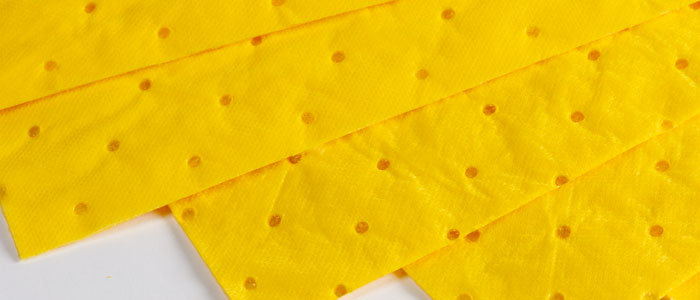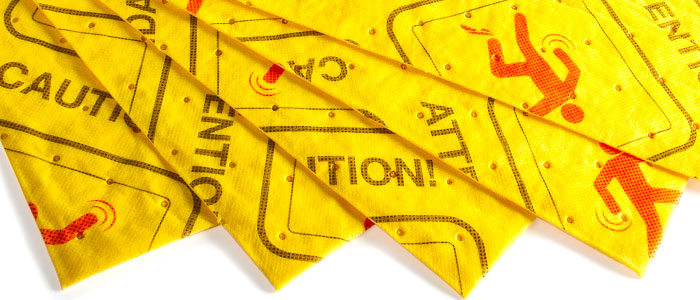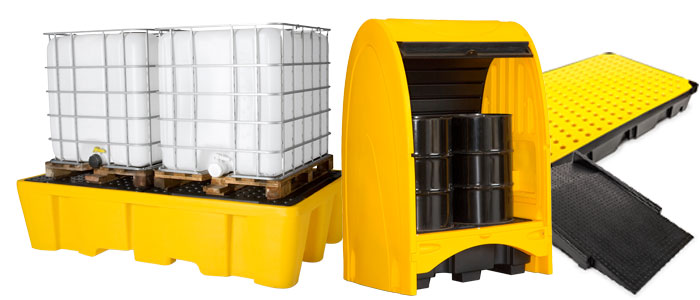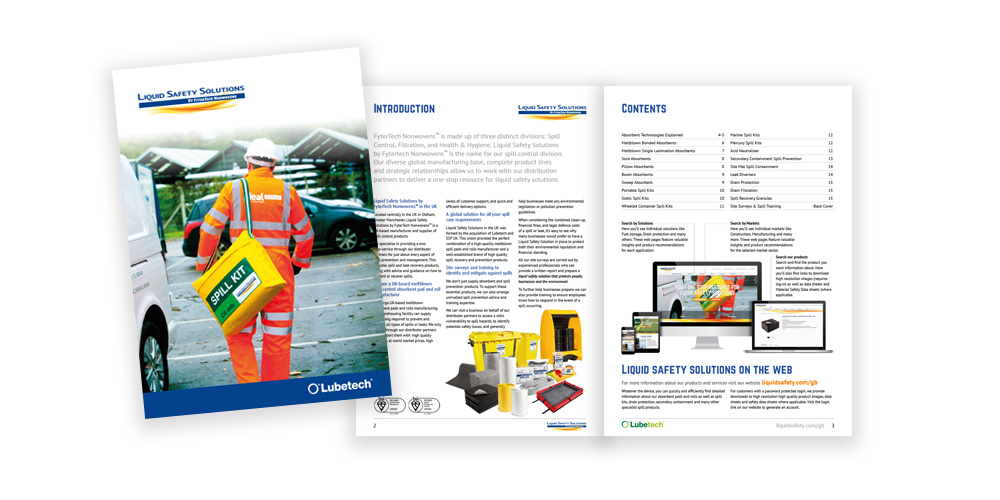Rail
Spill Control Solutions for Rail
Rail maintenance and operations covers a diverse range of locations, fluid types, and vehicle types.
Whether transporting people or goods, storing fluids at depots, or managing the fluids involved in the operations like refuelling or servicing transport, a wide range of liquid safety solutions are available to prevent or recover all natures of spills and leaks.
What type of absorbent is best suited for Rail?
Because of the diverse range of fluids involved in maintaining a fleet of vehicles both on and off the rails, as well as premises and depots, there are a number of different options to consider.

White coloured Oil Only absorbents are hydrophobic. They absorb oil-based fluids but repel water-based fluids. For locations outside, subjected to weather exposure, Oil only absorbents are particularly suited, as they will only recover oil-based fluids without soaking up any falling or pooled precipitation.

Grey/black Maintenance absorbents are hydrophilic and take up both water-based fluids along with oil-based fluids at the same time. These are the best all-round option for recovering spills or leaks of any type.

Yellow Chemical absorbents are also hydrophilic and will absorb both oil- and water-based fluids at the same time. The yellow colour of these absorbents indicates that they should be used for recovering aggressive fluids such as acids and alkalis and once used should be treated and disposed of with extreme caution.
In most instances a maintenance grey/black absorbent will be the optimum choice for fleet maintenance. Laminated pads are stronger so are better suited to repeated scrubbing of surfaces. Oil only white absorbents are particularly suited to cleaning vehicle engines during maintenance, refuelling and servicing. Yellow chemical absorbent is best to have available if aggressive substances like acids or alkalis are present. Most often a Chemical spill kit will be the best option for these kinds of spills.
All the of the above formats are made from meltblown polypropylene. They are inert and will not react with chemicals and are flame retardant (they will however burn if incinerated).
Environmentally friendly options
As an alternative to the above we offer a range of environmentally friendlier absorbents. These are either made from recycled meltblown polypropylene or are made from cellulose natural fibres. These environmentally friendly absorbents can be included towards achieving an ISO 14001 Environmental Management Standard.
Natural fibre absorbents are in some cases more absorbent or better suited to a specific task (absorbing anti-freeze for instance). However, choosing an environmentally friendly absorbent needs to be considered carefully as a used or contaminated absorbent will need to be disposed of exactly the same way as a meltblown polypropylene absorbent.
What absorbent formats are best suited to Rail industry applications?
Pads are available in different weights (light- through to -heavy weights) and also in un-bonded, bonded and laminated constructions. As a guide, the heavier the weight the more fluid it will absorb. With regards to the construction, laminated pads are stronger and feature less linting (stray fibres becoming detached). Bonded pads are slightly more absorbent, and un-bonded pads the most absorbent but not as strong. For wiping or rubbing we generally recommend a medium single laminate maintenance pad. All but the un-bonded pads feature perforations so that just the correct amount of absorbent can be selected.
Rolls are exactly the same as pads but instead are formed of longer lengths of absorbent which are rolled up. Rolls of absorbent are ideal for rolling out over larger areas to collect spilled or leaked fluids. We recommend a single laminate absorbent with the meltblown core face down. This maximises the absorption of fluids whilst reducing the slip risk. Ask us for our recommendations for your depot location(s).
Socks and Pillows are used to collect spills or leaks from around or beneath rail vehicles or track side machinery. Socks are used to contain the fluid by providing a barrier whilst also absorbing the liquid. Pillows are for capturing leaks or spills under machinery that are too big for a pad.
Drum tops are placed inside the top rim of a standard 210 litres (55 gallon) drum. They feature apertures for both pouring and breather holes.
Spill-Depot is a modular range of absorbent dispensers. They keep the absorbent in pristine condition and close at hand. They can be replenished at regular intervals to ensure absorbents are always available and ready for use.
Site Mat is a two-part unit which is placed under mobile plant or equipment when being refuelled or serviced. An inner polypropylene liner filters and traps the fuel or oil-based liquid while the porous side walls allow rainwater to simply run off.
Granules are loose absorbent applied to a spill. In our opinion pads will always provide a better spill recovery option when all aspects of safety, cost and disposal are taken into consideration. However, we do provide a range of granular absorbent for those who prefer it.
Safety-first High-Visibility absorbents

Our Spillfyter high-visibility range of absorbents are perfect for drawing attention to and warning of the slip-risk of spilled or leaked fluids whilst also recovering the spill or leaked fluid. These high visibility absorbents can be used in station concourses, platforms and depots or in areas where personnel gather such as canteens and operations rooms.
Bright yellow in colour, these absorbents will recover both oil-based and water-based fluids. They are made from meltblown polypropylene, which ensures they will not react with any chemicals present so are a perfect go-to first choice.
For unplanned liquid spills the high-visibility absorbent with warning text in three languages and graphics warns of the slip risk and recovers the leak or spill at the same time.
This range is available in pads, rolls, and wipes. They also feature a handy range of boxed dispensers and warning stands.
Protecting the workforce and public
To keep the workforce and public safe from slips, trips or injuries it is important to have enough absorbent available to recover leaks or spills. In most cases a spill kit provides what is required in a convenient pre-packed container.
Portable spill kits can be taken to the spill location or stored on-board a rail or road vehicle. These take the form of clip-close spill kits in either 15, 20 or 30ltr sizes. A vinyl satchel 50ltr edition is also available. These are ideal for getting a quantity of absorbent to difficult to access locations like trackside embankments.
Static spill kits can be located where there is a known risk of a spill occurring (like a traction depot or a freight loading facility). These will be more suited to locations where fluids are changed or handled more frequently.
Wheeled spill kits allow a large quantity of absorbents to be quickly moved to the site of a spill. These range from 120ltr wheelie bins up to four-wheeled 1,000ltr versions. Ask us for more details about which spill kits we recommend for different locations and spill types.
Specialist spill kits are designed with specific fluids in mind. We supply spill kits to recover mercury, bodily fluids and other unique applications. The bodily fluid spill kits are particularly suited for having onboard rail passenger vehicles or at station concourses.
Spill prevention equipment
To keep fluids containers safely stored, we have an extensive range of containment and storage units. These provide secure, robust solutions for a wide varied range of containers.

Workfloors are modular units with an integral sump built in. The sump catches any spilled fluids and can be drained off or recovered. Available in a range of sizes and with access ramps, they provide a flexible and reliable solution for managing containers of fluid consumables.
Spill Pallets are designed to store fluid contains such as oil drums. They also feature regulation compliant sump capacities to capture any spilled fluids. Available in a wide range of sizes and for different containers they are a ideal for storing fuel and cleaning fluids in locomotive depots and passenger rolling stock cleaning facilities. There are weathertight options too, which prevent rainwater filling the sump if stored outside.
Transporter units allow drums and containers to be transported around a site safely. They feature a regulation compliant built in additional fluid barrier capacity to prevent spilled fluids from reaching and polluting the environment.
Storage
We have a wide range of storage cupboards in metal and plastic. Available in different sizes and shapes, ask us for more details to suit specific requirements.
The law from the HSE
The Health and Safety at Work etc Act 1974 (HSWA)
The Health and Safety at Work Act 1974 requires employers to ensure the health and safety of all employees and anyone affected by their work, so far as is reasonably practicable, which means balancing the level of risk against the measures needed to control the risk in terms of money, time or trouble. This includes taking steps to control slip and trip risks.
Employees have a duty to take care of their own health and safety and that of others and must use any safety equipment provided.
Health and Safety at Work etc Act 1974
The Management of Health and Safety at Work Regulations 1999 (Regulation 3)
Build on the HSWA and include duties on employers to assess risks (including slip and trip risks) and take action where necessary.
Management of health and safety at work
The Workplace (Health, Safety and Welfare) Regulations 1992 (Regulation 12)
Require floors to be suitable, in good condition and free from obstructions. People should be able to move around safely.
The Workplace (Health, Safety and Welfare) Regulations 1992
Site Surveys and Spill Recovery training
To help you identify spill and leak risks we can provide a site survey. An experienced and highly knowledgeable member of our team can attend a business site and provide a written report identifying the risks. Along with the risk identification, a suggestions of liquid safety solutions will be suggested.
To allow a business’s employees to better respond to a spill we provide spill training to ensure that in the event of a spill everybody knows how to safely respond and follow a set procedure.


